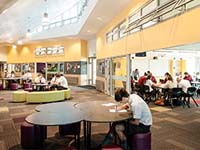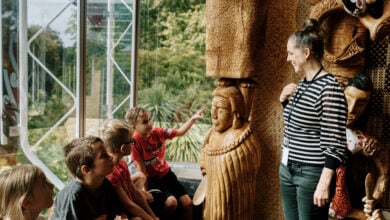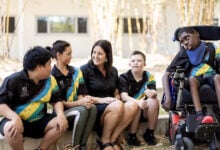Preparing for the future

 We are responsible for educating our children for a future that we cannot predict with environmental, health, social and economic issues on a global and local scale.
We are responsible for educating our children for a future that we cannot predict with environmental, health, social and economic issues on a global and local scale.
Our students need to be prepared to adapt to the changing world and schools have a key role to play in this process.
The roles of our teachers have expanded from delivering a set curriculum to facilitating student learning through project work and guided enquiry.
Such methods create a habit of a lifelong search for knowledge and provide our children with creative thinking and problem solving skills. School spaces have to keep up with these developments.
Formal expectations of Ministry of Education are comprehensive with 21st Century Learning objectives, Modern Learning Environments and future proofing buildings required, all of which are great concepts, but how to apply them to most existing school facilities which need more urgent work such as weather-tightness and seismic strengthening?
There is a lot to think about.
When making decisions about school assets, it is important to look forward and have a holistic view.
Take it step by step
You need to start with an overall site Master Plan and a 10 year Property Plan which are essential for both the long term spatial planning of facilities and financial planning of capital expenditure. Note that the Ministry of Education (MoE) requires that Health and Safety (including weather-tightness and seismic strengthening) and essential infrastructure projects be carried out within a school before Modern Learning Environment projects can be implemented.
Identifying which Health and Safety and essential infrastructure projects will contribute towards the long-term plan and will also show options which may create extra funds such as removing a building that requires costly weather-tightness or seismic strengthening work or other ways of rationalisation of space. Such options will in turn divert funding toward Modern Learning Environment projects that will have a more positive impact on learning outcomes.
The Master Plan should be developed alongside the pedagogical aspirations and curriculum vision of the school. Buildings can be expected to stand for 50 years with little or no change, but the pedagogical thinking continues to evolve all the time.
It is therefore essential that the design of the building will support educational and technological change without expensive remodelling. A variety of interconnected learning spaces that could be used in many different modes both now and in the future is a good and affordable option.
A shift in attitude towards rationalisation of property in favour of collaboration and sharing of facilities can also enable a better standard and allow the maintenance budget to go further.
How to future proof existing buildings?
When remodelling existing buildings it is important to assess the condition of both the site and building, and the ability of the existing structure to be adapted to suit modern learning objectives. There are a number of typical school buildings that can be transformed by opening up and creating connections between spaces or by reclaiming valuable corridor space for teaching and learning.
The redevelopment at Heretaunga College demonstrates how these principles have been achieved through refurbishment within the constraints of existing facilities.
Case Study – Heretaunga College Redevelopment, Upper Hutt
The redevelopment of Heretaunga College innovatively combined existing buildings and the new elements to transform the entire campus. The facility was opened in Feb 2013 by the Right Honourable John Key. In her speech Head Girl Haylee Groeneveld said “We now have something that shows on the outside how good we know we are on the inside.”
The objectives of the project were to embrace Ministry of Education objectives for Modern Learning and support the College vision for curriculum delivery. The redevelopment was delivered within a modest budget and to programme.
The entire school is connected by a central internal street or ‘spine’ and provides social spaces including a student run café and catering kitchen along its length.
This connectivity is also present in teaching and learning spaces which are clustered around new flexible shared-learning areas for each wing. The central space is formed to maximise natural ventilation and sunlight by use of roof lantern windows at high level. Sliding glass doors and internal glazing between refurbished and new spaces have improved passive surveillance, visibility and natural light. The administration area has been reconfigured to establish a central hub for student services including careers, guidance, health and pastoral care.
Outdoor spaces have also been reconfigured. Two major landscape areas have been created. The Café Plaza welcomes students and provides a social exterior space adjacent to the Spine Café and Student Entrance. Learning spaces flow out onto exterior decks around the perimeter of the new landscaped Quad space which is at heart of the school and is an important school community area used as a venue for outdoor learning, performance and places for students during break times.
This project shows that there are many ways in which spaces could be updated and future proofed. So next time you have the opportunity to plan a building project for your school keep the end in mind and look for potential within. It may only take a few adjustments to bring your long-term vision a little closer.









